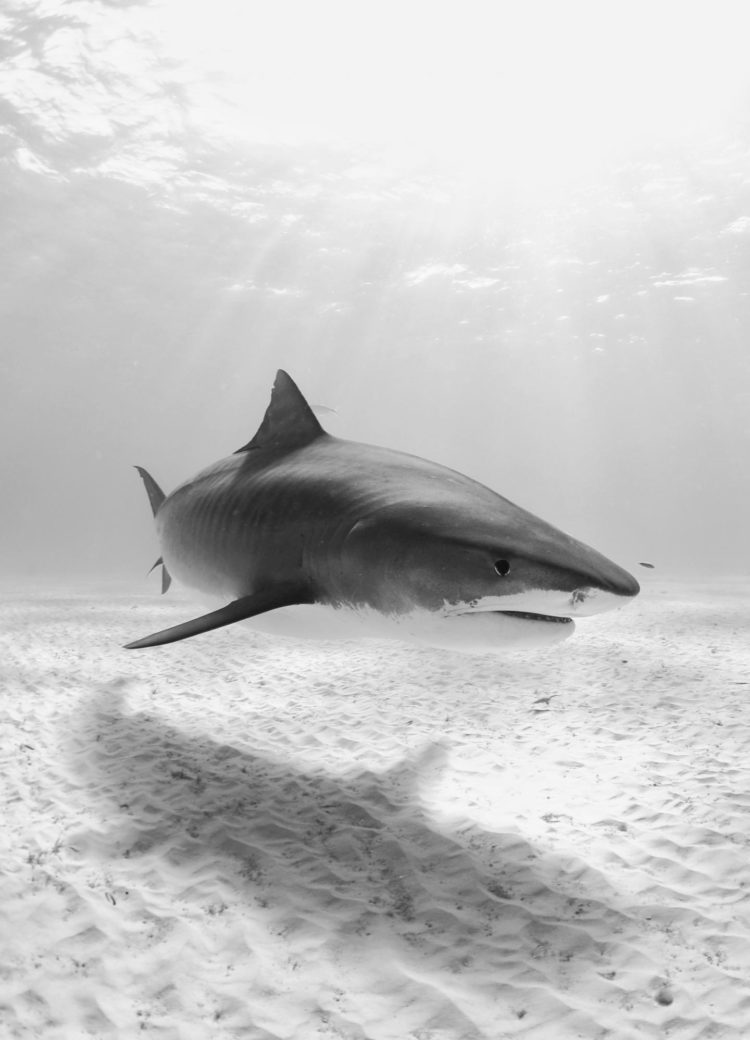Marine experts including a SoMAS scientist appeal to policy makers in a letter in Science

Credit: Austin Gallagher
STONY BROOK, February 13, 2020 — Governments must provide larger spatial protections in the Greater Caribbean for threatened, highly migratory species such as sharks, is the call from a diverse group of marine scientists including Stony Brook University School of Marine and Atmospheric Sciences (SoMAS) PhD Candidate, Oliver Shipley, and led by the conservation NGO Beneath the Waves in a letter to published in Science (Feb. 14).
With up to one-third of all open ocean shark species threatened extinction due to overfishing, conservation strategies that protect areas where sharks spent significant portions of their time are becoming increasingly important. In light of recent calls to protect 30 percent of our oceans by 2030, large marine protected areas, which can stretch from 100,000 sq. km to over 300,000 sq. km, have emerged as a popular management tool for their potential to enhance ecological processes and promote sustainable fisheries. One of the greatest benefits of these large conservation zones is their potential to conserve sharks, which travel long distances and can connect multiple jurisdictions over short time periods.
The letter in Science states that the Greater Caribbean, which boasts some of the highest rates of marine biodiversity and contains some of the most migratory shark species in the world, has been overlooked in these conversations.
“Through conducting years of scientific research on sharks in the Caribbean, I have witnessed first-hand, the benefits that marine protected areas can have for shark populations,” said Shipley, a close collaborator of Dr. Austin Gallagher, Chief Scientist at Beneath the Waves. “We hope that currently protected nations, such as The Bahamas, can carry the torch and provide a foundation on which to base broader policy. For this to be a success, we will need to continue to build strong relationships and further understand the needs of key stakeholder groups throughout the wider Caribbean. We are extremely confident that this is going to happen.”
“The diversity of countries sharing ocean space in the Greater Caribbean is remarkable, and we know that migratory shark species connect many of these countries along their migrations,” said Gallagher. “Though there are many examples of establishing marine protected areas in the region, there are few that are big enough to encompass the space use of large sharks, such as tiger sharks which can move thousands of miles per year.”
Recent research suggests that sharks are surprisingly rare in many Caribbean nations, likely due to decades of unregulated overharvest. However, certain areas such as the Bahamas, which have banned longline fishing and protected sharks in recent decades, have benefitted from the significant socioeconomic inputs generated from live sharks in the diving industry, estimated to be over US $140 million per year.
###
Additional authors include Diva Amon (Natural History Museum London/SpeSeas), Tadzio Bervoets (Dutch Caribbean Nature Alliance), Neil Hammerschlag (University of Miami), and David Sims (Marine Biological Association of the UK/University of Southhampton).
About Stony Brook University
Stony Brook University, widely regarded as a SUNY flagship, is going far beyond the expectations of today’s public universities. With more than 26,000 students, 2,700 faculty members, nearly 200,000 alumni, an academic medical center and 18 NCAA Division I athletic programs, it is one of only four University Center campuses in the State University of New York (SUNY) system. The University embraces its mission to provide comprehensive undergraduate, graduate, and professional education of the highest quality, and has been ranked among the top 35 public universities in the nation by U.S. News & World Report. Fostering a commitment to academic research and intellectual endeavors, Stony Brook’s membership in the Association of American Universities (AAU) places it among the top 65 research institutions in North America. The University’s distinguished faculty have earned esteemed awards such as the Nobel Prize, Pulitzer Prize, Indianapolis Prize for animal conservation, Abel Prize and the inaugural Breakthrough Prize in Mathematics. Part of the management team of Brookhaven National Laboratory of the U.S. Department of Energy, Stony Brook is one of only eight universities that has a role in running a national laboratory. Providing economic growth for neighboring communities and the wider geographic region, the University totals an impressive $7.23 billion in increased economic output on Long Island. Follow us on Facebook (https:/
Media Contact
Greg Filiano
[email protected]
631-444-9343
Related Journal Article
http://dx.





